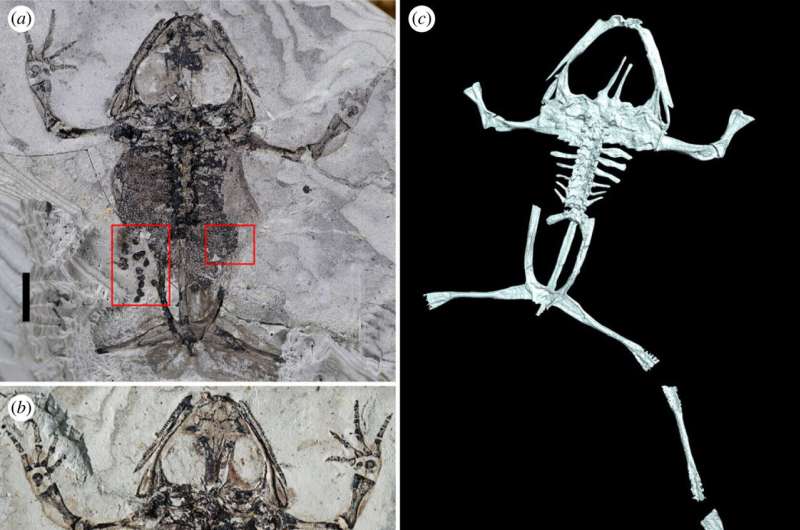February 7, 2024 report
This article has been reviewed according to Science X's editorial process and policies. Editors have highlighted the following attributes while ensuring the content's credibility:
fact-checked
peer-reviewed publication
trusted source
proofread
Fossilized frog with belly full of eggs unearthed in China is oldest of its kind

An international team of Earth scientists, evolutionary biologists and paleontologists has unearthed an ancient frog with a belly full of eggs, the oldest known find of its kind. In their paper published in Proceedings of the Royal Society B, the group describes the frog, where it was found, how long ago it lived and where it fits in the frog family tree.
Prior research has shown that female frogs produce eggs in their bellies, and once mature, the eggs are laid and then fertilized by a male. In this new study, the research team uncovered a fossilized frog in the Zhonggou Formation of the Hanxia outcrop. Testing showed it to be from the Lower or Early Cretaceous, suggesting the frog lived approximately 100 million years ago, during the time of the dinosaurs.
The research team scanned the fossil with a CT scanner and learned that the frog was a member of the species Gansubatrachus qilianensis, it was not fully mature, and it had a belly full of eggs, some of which were in the process of being laid, and the team promptly X-rayed them. The findings showed that although still skeletally immature, the frog was fully capable of reproduction—the first time this has been seen in such an ancient frog.
The research team ruled out old age as the cause of death, and it did not appear the frog had died from problems in its water source, such as a sudden algae bloom. They also noted that few other frogs had been preserved in the area, ruling out the likelihood of some other environmental problem.
They suggest the most likely cause of death was suffocation due to weakness related to the behavior of a male frog. Prior research has shown that to ensure fertilizing a female's eggs, males employ amplexus, which is where they embrace the female to prevent her from moving around. Modern male frogs have been known to engage in amplexus for hours, sometimes days, at a time, which is long enough for the female to die from exhaustion or suffocation.
More information: Baoxia Du et al, A cretaceous frog with eggs from northwestern China provides fossil evidence for sexual maturity preceding skeletal maturity in anurans, Proceedings of the Royal Society B: Biological Sciences (2024). DOI: 10.1098/rspb.2023.2320
Journal information: Proceedings of the Royal Society B
© 2024 Science X Network





















